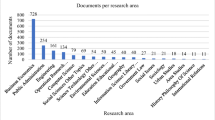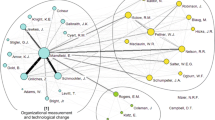Abstract
Over the last decades there has been a growing interest on developing research and formulating public policy by using the Innovation Systems approach. However, as evidenced on the academic literature there is a lack of systematic, chronological and synthesizing studies indicating how this field has evolved over time. This paper has as main objective to consolidate the state of the art of academic research on IS, based on a bibliometrics study on literature published over the past 35 years. The results are discussed under the following perspectives: general results, chronological distribution, author relevance, articles and cited references of relevance, journals relevance and institutions and countries relevance. The paper ends with a discussion of the main implications and limitations of the study.


Similar content being viewed by others
Notes
It is worth to mention that since the study was carried out on an electronic database containing solely peer-reviewed articles, other bibliographical material like books, government and supranational reports were not taken into account unless otherwise noted.
References
Archibugi, D., & Michie, J. (1995). The globalization of technology—A new taxonomy. Cambridge Journal of Economics, 19(1), 121–140.
Arundel, A., Lorenz, E., Lundvall, B. Ã., & Valeyre, A. (2007). How Europe’s economies learn: A comparison of work organization and innovation mode for the EU-15. Industrial and Corporate Change, 16(6), 1175–1210.
Bellis, N. d. (2009). Bibliometrics and citation analysis: From the science citation index to cybermetrics. Maryland: Scarecrow Press.
Bowonder, B., & Miyake, T. (1992). A model of corporate innovation management—some recent high tech innovations in japan. R & D Management, 22(4), 319–335.
Braczyk, H.-J., Cooke, P., & Heidenreich, M. (1998). Regional innovation systems: The role of governances in a globalized world. London: University College London Press.
Brooks, H. (1975). Military innovation system and qualitative arms-race. Daedalus, 104(3), 75–97.
Carlsson, B., & Stankiewicz, R. (1991). On the nature, function and composition of technological systems. Journal of Evolutionary Economics, 1(2), 93–118.
Carlsson, B., Jacobsson, S., Holmen, M., & Rickne, A. (2002). Innovation systems: Analytical and methodological issues. Research Policy, 31(2), 233–245.
Cohen, W. M., & Levinthal, D. A. (1990). Absorptive capacity: A new perspective on learning and innovation. Administrative Science Quarterly, 35(1, Special Issue: Technology, Organizations and Innovation), 128–152.
Cooke, P. (1992). Regional innovation systems—competitive regulation in the new Europe. Geoforum, 23(3), 365–382.
Cooke, P., Uranga, M. G., & Etxebarria, G. (1997). Regional innovation systems: Institutional and organisational dimensions. Research Policy, 26(4–5), 475–491. doi:10.1016/S0048-7333(97)00025-5.
Cooke, P., Uranga, M. G., & Etxebarria, G. (1998). Regional systems of innovation: An evolutionary perspective. Environment and Planning A, 30(9), 1563–1584.
Dosi, G. (1982). Technological paradigms and technological trajectories—A suggested interpretation of the determinants and directions of technical change. Research Policy, 11, 147–162.
Dosi, G., Freeman, C., Nelson, R. R., Silverberg, G., & Soete, L. (Eds.). (1988). Technical change and economic theory. London: Pinter Publishers.
Edgington, D. W. (2008). The Japanese innovation system: University—industry linkages, small firms and regional technology clusters. Prometheus, 26(1), 1–19.
Edquist, C. (1997). Systems of innovation. Technologies, institutions and organizations. London: Pinter Publishers.
Etzkowitz, H., & Leydesdorff, L. (2000). The dynamics of innovation: From national systems and “Mode 2” to a triple helix of university–industry–government relations. Research Policy, 29(2), 109–123.
Freeman, C. (1987). Technology policy and economic performance: Lessons from Japan. London: Pinter Publishers.
Freeman, C. (1988). Japan: A new national innovation system? In G. Dosi, C. Freeman, R. R. Nelson, G. Silverberg, & L. Soete (Eds.), Technical change and economic theory (pp. 330–348). London: Pinter Publishers.
Freeman, C. (1995). The ‘National System of Innovation’ in historical perspective. Cambridge Journal of Economics, 19(1), 5–24.
Freeman, C. (2002). Continental, national and sub-national innovation systems—Complementarity and economic growth. Research Policy, 31(2), 191–211.
Freeman, C. (2004). Technological infrastructure and international competitiveness. Industrial and Corporate Change, 13(3), 541–569. doi:10.1093/icc/dth022.
Freeman, C., & Soete, L. (2009). Developing science, technology and innovation indicators: What we can learn from the past. Research Policy, 38(4), 583–589. doi:10.1016/j.respol.2009.01.018.
Furman, J. L., Porter, M. E., & Stern, S. (2002). The determinants of national innovative capacity. Research Policy, 31(6), 899–933.
Garfield, E., Sher, I. H., & Torpie, R. J. (1964). The use of citation data in writing the history of science. Philadelphia: Institute for Scientific Information Inc.
Gibbons, M., Limoges, C., Nowotny, H., Schwartzman, S., Scott, P., & Trow, M. (1994). The new production of knowledge: The dynamics of science and research in contemporary societies. London: Sage Publications.
Godin, B. (2009). National innovation system: The system approach in historical perspective. Science Technology Human Values, 34(4), 476–501. doi:10.1177/0162243908329187.
Granstrand, O., Bohlin, E., Oskarsson, C., & Sjoberg, N. (1992). External technology acquisition in large multitechnology corporations. R & D Management, 22(2), 111–133.
Hekkert, M. P., & Negro, S. O. (2009). Functions of innovation systems as a framework to understand sustainable technological change: Empirical evidence for earlier claims. Technological Forecasting and Social Change, 76(4), 584–594. doi:10.1016/j.techfore.2008.04.013.
Krupp, H. (1983). Overview of policy issues—panel report on the functions of non-university research institutes in national R-and-D and innovation systems and the contributions of universities. Technology in Society, 5(3–4), 251–256.
Lee, S. H., & Yoo, T. (2007). Government policy and trajectories of radical innovation in dirigiste states: A comparative analysis of national innovation systems in France and Korea. Technology Analysis & Strategic Management, 19, 451–470. doi:10.1080/09537320701403383.
Lundvall, B. A. (1988). Innovation as an interactive process. From user-producer interaction to the national system of innovation. In G. Dosi, C. Freeman, R. Nelson, G. Silverberg, & L. Soete (Eds.), Technical change and economic theory (pp. 349–369). London: Pinter Publishers.
Lundvall, B. A. (1992). National systems of innovation. Towards a theory of innovation and interactive learning. London: Pinter Publishers.
Lundvall, B. A. (1998). Why study national systems and national styles of innovation? Technology Analysis & Strategic Management, 10(4), 407–421.
Lundvall, B. A. (2004). Introduction to ‘Technological infrastructure and international competitiveness’ by Christopher Freeman. Industrial and Corporate Change, 13(3), 531–539. doi:10.1093/icc/dth021.
Lundvall, B. A., Johnson, B., Andersen, E. S., & Dalum, B. (2002). National systems of production, innovation and competence building. Research Policy, 31(2), 213–231.
Macdowall, J. (1984). The technology innovation system in Japan. Journal of Product Innovation Management, 1(3), 165–172.
Malerba, F. (2002). Sectoral systems of innovation and production. Research Policy, 31(2), 247–264.
Malerba, F., & Orsenigo, L. (1999). Technological entry, exit and survival: An empirical analysis of patent data. Research Policy, 28(6), 643–660.
Meyer-Krahmer, F., & Schmoch, U. (1998). Science-based technologies: University–industry interactions in four fields. Research Policy, 27(8), 835–851.
Morgan, K. (1997). The learning region: Institutions, innovation and regional renewal. Regional Studies, 31, 491–503.
Morgan, K. (2004). The exaggerated death of geography: Learning, proximity and territorial innovation systems. Journal of Economic Geography, 4(1), 3–21.
Mowery, D. C. (1992). The U.S. national innovation system: Origins and prospects for change. Research Policy, 21(2), 125–144.
Nelson, R. R. (1988). Institutions supporting technical change in the United States. In G. Dosi, C. Freeman, R. R. Nelson, G. Silverberg, & L. Soete (Eds.), Technical change and economic theory (pp. 312–329). London: Pinter Publishers.
Nelson, R. R. (1992). National innovation systems: A retrospective on a study. Industrial and Corporate Change, 1(2), 347–374. doi:10.1093/icc/1.2.347.
Nelson, R. R. (1993). National innovation systems: A comparative analysis. Oxford: Oxford University Press.
Nelson, R. R. (2007). Economic development from the perspective of evolutionary economic theory. Globelics Working Paper Series (p. 25). Beijing: Globelics.
Nelson, R. R., & Winter, S. (1982). An evolutionary theory of economic change. Cambridge: Harvard University Press.
Niosi, J., & Tschang, F. T. (2009). The strategies of Chinese and Indian software multinationals: Implications for internationalization theory. Industrial and Corporate Change, 18(2), 269–294. doi:10.1093/icc/dtp005.
Niosi, J., Saviotti, P., Bellon, B., & Crow, M. (1993). National systems of innovation: In search of a workable concept. Technology in Society, 15(2), 207–227.
OECD (Ed.). (1997). National innovation systems. Paris: OECD Publishing.
OECD (Ed.). (2009a). Measuring China’s innovation system—National specificities and international comparisons (Statistical Analysis of Science, Technology and Industry). Paris: OECD Publishing.
OECD (Ed.). (2009b). OECD reviews of innovation policy—Korea. Paris: OECD.
Okubo, Y. (1997). Bibliometric indicators and analysis of research systems: Methods and examples. Paris: OECD, Directorate for Science, Technology and Industry.
Pavitt, K. (1984). Sectoral patterns of technical change: Towards a taxonomy and a theory. Research Policy, 13, 343–373.
Porter, M. E. (1990). The competitive advantage of nations. New York: Free Press.
Santos, R. N. M. (2003). Indicadores estratégicos em ciência e tecnologia: refletindo a sua prática como dispositivo de inclusão/exclusão social. TransInformação, 15(Edição Especial), 129–140.
Santos, R. N. M., & Kobashi, N. Y. (2009). Bibliometria, cientometria, infometria: conceitos e aplicações. Pesq. bras. Ci. Inf., 2(1), 155–172.
Shapiro, I. S. (1979). Does the judicial system stifle innovation? Judicature, 63(2), 57–58.
Sharif, N. (2006). Emergence and development of the National Innovation Systems concept. Research Policy, 35(5), 745–766.
Small, H. (1973). Cocitation in scientific literature—New measure of relationship between 2 documents. Journal of the American Society for Information Science, 24(4), 265–269.
Storper, M. (1997). The regional world: Territorial development in a global economy. New York: The Guilford Press.
Thornton, R. (1979). Patent issue—Effects of the patent system on innovation. Research Management, 22(2), 33–35.
van Leeuwen, T. N. (2006). The application of bibliometric analyses in the evaluation of social science research. Who benefits from it, and why it is still feasible. Scientometrics, 66(1), 133–154. doi:10.1007/s11192-006-0010-7.
van Leeuwen, T. N., Visser, M. S., Moed, H. F., Nederhof, T. J., & van Raan, A. F. J. (2003). Holy Grail of science policy: Exploring and combining bibliometric tools in search of scientific excellence. Scientometrics, 57(2), 257–280.
van Raan, A. F. J. (2003). The use of bibliometric analysis in research performance assessment and monitoring of interdisciplinary scientific developments. Technikfolgenabschätzung—Theorie und Praxis, 12(1), 20–29.
Vanti, N. A. P. (2002). Da bibliometria à webometria: uma exploração conceitual dos mecanismos utilizados para medir o registro da informação e a difusão do conhecimento. Ci. Inf., 31(2), 152–162.
Author information
Authors and Affiliations
Corresponding author
Rights and permissions
About this article
Cite this article
Uriona-Maldonado, M., dos Santos, R.N.M. & Varvakis, G. State of the art on the Systems of Innovation research: a bibliometrics study up to 2009. Scientometrics 91, 977–996 (2012). https://doi.org/10.1007/s11192-012-0653-5
Received:
Published:
Issue Date:
DOI: https://doi.org/10.1007/s11192-012-0653-5




